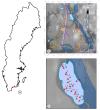Impact of the Sediment Organic vs. Mineral Content on Distribution of the Per- and Polyfluoroalkyl Substances (PFAS) in Lake Sediment
- PMID: 32764393
- PMCID: PMC7459773
- DOI: 10.3390/ijerph17165642
Impact of the Sediment Organic vs. Mineral Content on Distribution of the Per- and Polyfluoroalkyl Substances (PFAS) in Lake Sediment
Abstract
Contamination of the water and sediment with per- and polyfluoroalkyl substances (PFAS) was studied for the lake impacted by the release of PFAS-containing aqueous film forming foam (AFFF). PFAS concentrations were analyzed in lake water and sediment core samples. ΣPFAS concentrations were in the range of 95-100 ng L-1 in the lake water and 3.0-61 µg kg-1 dry weight (dw) in sediment core samples, both dominated by perfluorohexane sulfonate, perfluorooctane sulfonate; 6:2 fluortelomer sulfonate was inconsistently present in water and sediment core samples. The sediment-water partitioning coefficients (log Kd) were estimated and ranged 0.6-2.3 L kg-1 for individual perfluoroalkyl carboxylates (PFCAs) and 0.9-5.6 L kg-1 for individual perfluoroalkane sulfonates (PFSAs). The influence of the sediment inorganic content and organic matter on PFAS distribution was investigated. In studied sediments, the mineral content (corresponding to <5% of the bulk media mass) was mainly represented by sulfur, iron and calcium. The PFAS distribution was found strongly connected to the sediment mineral content (i.e., Fe, Pb, Rb and As), whereas the sediment organic carbon content did not to have a direct influence on the PFAS distribution. The aim of this study was to improve our understanding of the PFAS distribution in the natural heterogeneous media.
Keywords: AFFF; PFAS; distribution; sediment; water.
Conflict of interest statement
The authors declare no conflict of interest. The funders had no role in the design of the study; in the collection, analyses, or interpretation of data; in the writing of the manuscript, or in the decision to publish the results.
Figures



References
-
- Buck R.C., Franklin J., Berger U., Conder J.M., Cousins I.T., De Voogt P., Jensen A.A., Kannan K., Mabury S.A., Van Leeuwen S.P. Perfluoroalkyl and polyfluoroalkyl substances in the environment: Terminology, classification, and origins. Integr. Environ. Assess. Manag. 2011;7:513–541. doi: 10.1002/ieam.258. - DOI - PMC - PubMed
Publication types
MeSH terms
Substances
LinkOut - more resources
Full Text Sources
Research Materials

